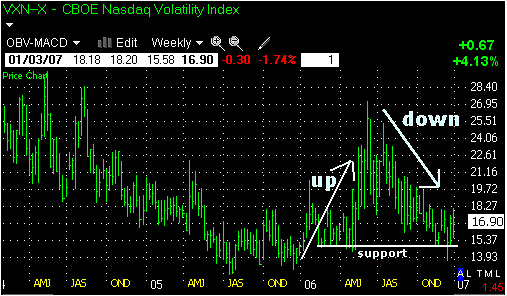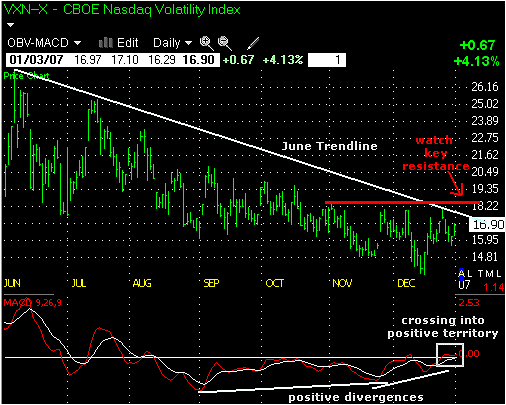
HOT TOPICS LIST
- MACD
- Fibonacci
- RSI
- Gann
- ADXR
- Stochastics
- Volume
- Triangles
- Futures
- Cycles
- Volatility
- ZIGZAG
- MESA
- Retracement
- Aroon
INDICATORS LIST
LIST OF TOPICS
PRINT THIS ARTICLE
by Arthur Hill
The NASDAQ 100 Volatility Index has been slowly building a base, and traders should watch for a resistance breakout to solidify a trend change.
Position: Hold
Arthur Hill
Arthur Hill is currently editor of TDTrader.com, a website specializing in trading strategies, sector/industry specific breadth stats and overall technical analysis. He passed the Society of Technical Analysts (STA London) diploma exam with distinction is a Certified Financial Technician (CFTe). Prior to TD Trader, he was the Chief Technical Analyst for Stockcharts.com and the main contributor to the ChartSchool.
PRINT THIS ARTICLE
VOLATILITY
Remember The Volatility Index?
01/03/07 02:23:32 PMby Arthur Hill
The NASDAQ 100 Volatility Index has been slowly building a base, and traders should watch for a resistance breakout to solidify a trend change.
Position: Hold
| In 2006 the NASDAQ 100 Volatility Index ($VXN) surged the first half of the year and fell the second half. Despite two big moves, the ultimate change from January to December was relatively small. Currently, the VXN is trading back near support around 15, and this area marked support from February to May 2006. The indicator is firming once again and traders should be on guard for a breakout. This indicator is important because the NASDAQ is negatively correlated (the NASDAQ usually moves up when VXN moves down and moves down when VXN moves up). See Figure 1. |

|
| FIGURE 1: NASDAQ 100 VOLATILITY INDEX, WEEKLY. VXN surged the first half of the year and fell the second. |
| Graphic provided by: TC2000.com. |
| Graphic provided by: Telechart 2007. |
| |
| On the daily chart (Figure 2), VXN remains in a downtrend and needs to break 18.2 for a reversal. The indicator remains below the June trendline and prior highs. An uptrend is impossible as long as both hold. There are three ingredients to an uptrend: trendline break, higher high, and higher low. VXN is zero for three right now. A break above 18.2 would forge a higher high and trendline break. This would quickly change the count (two out of three), and the odds of a trend reversal would greatly increase. |

|
| FIGURE 2: NASDAQ 100 VOLATILITY INDEX, DAILY. VXN remains in a downtrend in the daily chart and needs to break 18.2 for a reversal. |
| Graphic provided by: TC2000.com. |
| Graphic provided by: Telechart 2007. |
| |
| The moving average convergence/divergence (MACD) shows improving momentum and recently turned positive. Even though the NASDAQ 100 Volatility Index is an indicator, it is a price series and we can apply momentum indicators. The MACD moved into negative territory in mid-August and remained in negative territory until December 8. The early December crossover was brief and the indicator moved back into positive territory at the end of the month. The MACD turned positive for the first time in months and this could be the start of a trend reversal for VXN. The start of an uptrend in VXN would be negative to the NASDAQ. |
Arthur Hill is currently editor of TDTrader.com, a website specializing in trading strategies, sector/industry specific breadth stats and overall technical analysis. He passed the Society of Technical Analysts (STA London) diploma exam with distinction is a Certified Financial Technician (CFTe). Prior to TD Trader, he was the Chief Technical Analyst for Stockcharts.com and the main contributor to the ChartSchool.
| Title: | Editor |
| Company: | TDTrader.com |
| Address: | Willem Geetsstraat 17 |
| Mechelen, B2800 | |
| Phone # for sales: | 3215345465 |
| Website: | www.tdtrader.com |
| E-mail address: | arthurh@tdtrader.com |
Traders' Resource Links | |
| TDTrader.com has not added any product or service information to TRADERS' RESOURCE. | |
Click here for more information about our publications!
Comments
Date: 01/03/07Rank: 5Comment:
Date: 01/03/08Rank: 3Comment:

|

Request Information From Our Sponsors
- StockCharts.com, Inc.
- Candle Patterns
- Candlestick Charting Explained
- Intermarket Technical Analysis
- John Murphy on Chart Analysis
- John Murphy's Chart Pattern Recognition
- John Murphy's Market Message
- MurphyExplainsMarketAnalysis-Intermarket Analysis
- MurphyExplainsMarketAnalysis-Visual Analysis
- StockCharts.com
- Technical Analysis of the Financial Markets
- The Visual Investor
- VectorVest, Inc.
- Executive Premier Workshop
- One-Day Options Course
- OptionsPro
- Retirement Income Workshop
- Sure-Fire Trading Systems (VectorVest, Inc.)
- Trading as a Business Workshop
- VectorVest 7 EOD
- VectorVest 7 RealTime/IntraDay
- VectorVest AutoTester
- VectorVest Educational Services
- VectorVest OnLine
- VectorVest Options Analyzer
- VectorVest ProGraphics v6.0
- VectorVest ProTrader 7
- VectorVest RealTime Derby Tool
- VectorVest Simulator
- VectorVest Variator
- VectorVest Watchdog
